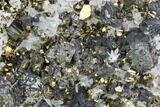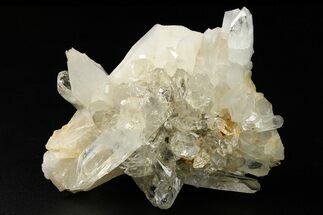This Specimen has been sold.
3.9" Quartz, Sphalerite and Pyrite Association - Peru
This is a beautiful specimen that contains an association of pyrite, sphalerite and quartz crystals. It comes from the Huanzala Mine in Peru and the entire specimen measures 3.9" long.
It comes with an acrylic display stand.
It comes with an acrylic display stand.
Sphalerite is a part of the sulfide group and typically exhibits a grey/black appearance due to high concentrations of impurities. In its purest state, sphalerite's chemical composition is ZnS, and can display a gemmy transparent light tan/yellow color. This is one of the few minerals that can form crystals ranging anywhere between gemmy and transparent to opaque and metallic-like. Opaque or cloudy sphalerite tends to be most abundant since iron easily replaces zinc in the process of formation.
About Quartz
Quartz is the name given to silicon dioxide (SiO2) and is the second most abundant mineral in the Earth's crust. Quartz crystals generally grow in silica-rich environments--usually igneous rocks or hydrothermal environments like geothermal waters--at temperatures between 100°C and 450°C, and usually under very high pressure. In either case, crystals will precipitate as temperatures cool, just as ice gradually forms when water freezes. Quartz veins are formed when open fissures are filled with hot water during the closing stages of mountain formation: these veins can be hundreds of millions of years old.
Quartz is the name given to silicon dioxide (SiO2) and is the second most abundant mineral in the Earth's crust. Quartz crystals generally grow in silica-rich environments--usually igneous rocks or hydrothermal environments like geothermal waters--at temperatures between 100°C and 450°C, and usually under very high pressure. In either case, crystals will precipitate as temperatures cool, just as ice gradually forms when water freezes. Quartz veins are formed when open fissures are filled with hot water during the closing stages of mountain formation: these veins can be hundreds of millions of years old.
About Pyrite
Pyrite, or iron pyrite, is best known as “Fool’s Gold” thanks to its bright metallic luster and pale brass-yellow color, which can easily be mistaken for real gold in poor lighting. With the chemical formula FeS₂, pyrite is the most abundant sulfide mineral on Earth and forms in an impressive range of geological environments.
One of pyrite’s defining features is its remarkable diversity of crystal habits—over 20 documented forms—making it one of the most morphologically varied minerals known. It commonly occurs as sharp cubes, octahedra, and pyritohedra, but also forms pentagonal dodecahedra, penetration twins, striated combinations, and complex modified forms prized by collectors. It can develop as massive veins, nodules, botryoidal growths, and fine druzy coatings that shimmer brilliantly under light. Whether glittering in tiny clusters or displayed as perfectly geometric crystals, pyrite showcases an extraordinary range of natural architecture and visual appeal.
Pyrite, or iron pyrite, is best known as “Fool’s Gold” thanks to its bright metallic luster and pale brass-yellow color, which can easily be mistaken for real gold in poor lighting. With the chemical formula FeS₂, pyrite is the most abundant sulfide mineral on Earth and forms in an impressive range of geological environments.
One of pyrite’s defining features is its remarkable diversity of crystal habits—over 20 documented forms—making it one of the most morphologically varied minerals known. It commonly occurs as sharp cubes, octahedra, and pyritohedra, but also forms pentagonal dodecahedra, penetration twins, striated combinations, and complex modified forms prized by collectors. It can develop as massive veins, nodules, botryoidal growths, and fine druzy coatings that shimmer brilliantly under light. Whether glittering in tiny clusters or displayed as perfectly geometric crystals, pyrite showcases an extraordinary range of natural architecture and visual appeal.
SPECIES
Quartz, Sphalerite & Pyrite
LOCATION
Huanzala Mine, Bolognesi, Peru
SIZE
3.9" wide
CATEGORY
SUB CATEGORY
ITEM
#126556
 Reviews
Reviews













